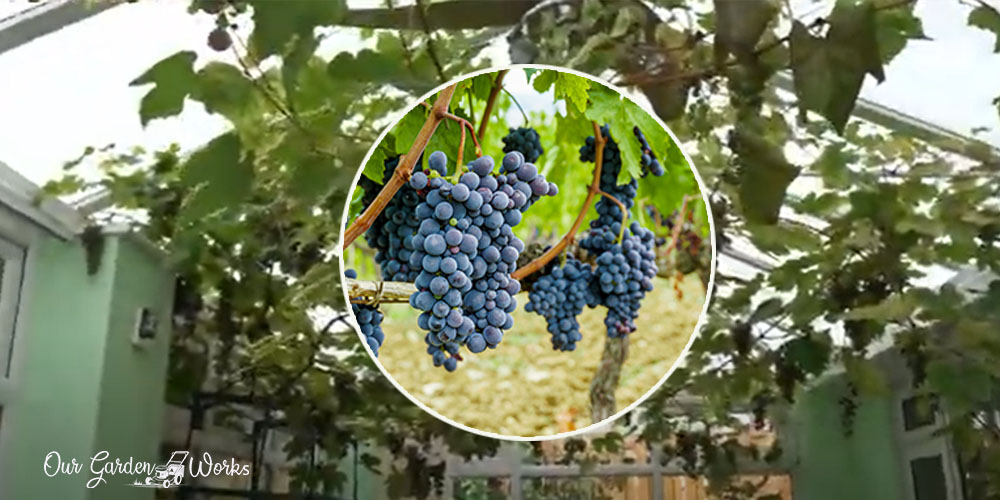Our generation is lucky enough to have resources in growing edible plants indoors. Though uncommon, growing grapes indoors can be one of the new gardening experiences that you can tap into this year. Commonly found in vineyards, grapes can grow anywhere as long as their growing conditions are met.
In this post, we will discuss how you can start growing grapes in a sunny room or a greenhouse.
If you have a spare space to grow some edibles, grapes can be a new crop you can add to your long list of gardening experiences. According to Ohio State University, a vine can produce 40 clusters of grapes equivalent to 10 bottles of wine.
Imagine the fun of growing your wine in the comforts of your small home. Amazing, isn’t it?
Before we head to the step-by-step guide on growing grapes indoors, it’s best to learn more about grapes as a plant. Learning more about something allows you to care for it better during the growing period.
(You could use the table of contents below to jump to the sections that are most important to you.)
Getting To Know Your Grapes
Grape is a woody perennial vine that needs warm weather and heat from the sun to ripen its fruits. Its leaves and fruits grow in its cane as its vines crawl their way up. Unlike other plants, grapes produce suckers next to their stem and spread their roots up to 6 feet.
Since grapes have woody vines, they have different parts that are not typical in any crop you’ll find in the garden.
To be a full sworn grape parent, learn more about the parts of a grapevine below:
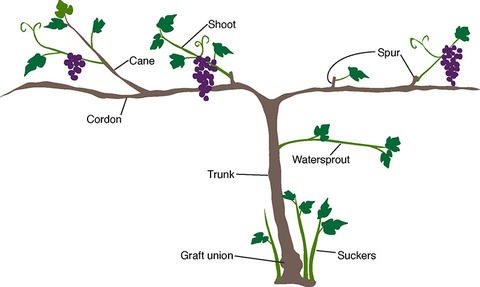
Parts of a Grapevine
- Trunk: The former shoot trained to be the stem of the plant. It holds all the parts of the plant and the source of all the sprouting flowers, leaves, and other parts of the vine.
- Shoot: It holds the leaves, fruits, and flowers of the grapevine. It is the part that you need to focus on and train throughout the growing period of the vine.
- Canes: The matured shoot that develops its bark and woody structure during the winter-dormant phase of a grapevine.
- Cordons: The semi-permanent branches of the vine.
- Spur: Every winter the grapevine should be cut back to maintain the quality of its fruits. The fruiting vines are cut back into two bud spurs to prepare them for spring.
- Tendrils: The twisting and clinging stem-like part of a vine that helps the vine cling onto a trellis or stake.
- Buds: The compressed shoots during the dormancy period. When the spring comes, the buds will expand as a new shoot grows from it. The buds are carefully managed in different vine training systems to produce a well-growing grapevine every growing season.
- Suckers and watersprouts: These are the shoot growth on the stem and the crown base of the plant.
Grape Variety and The Importance of Vine Training Systems

The grape variety matters when you want to produce a specific product. For example, if you aim to make wine out of your grape plants, the grape variety that you choose should be abundant in acid, sugar, and skin-to-pulp ratio. If you aim to make grape jellies, you must opt for winter-hardy grape varieties.
Grapevine training systems are necessary for growing grapes. It ensures the quality of the fruits and makes the vines look orderly and managed.
An uncontrolled vine will produce poor-quality grapes that can affect the flavor of your wine or grape jellies. Grapevine shoots will grow anywhere in the plant and create unnecessary shade on the fruits.
Check the image below for the comparison of controlled and uncontrolled grapevine growth.
Grapes grown indoors can also be prone to overgrowth. Managing the vines and training them as they grow is necessary to control the flavor and quality of the fruits.
Pruning and cutting back vines also ensures that the vines will grow in a desirable design inside your house and not make your growing area look like a jungle.
Grape Varieties Ideal For Growing Indoors
You can achieve your desired grape quality and flavor using the appropriate grape variety.
For indoor cultivation of grapes, here are the best grape varieties that you can try to grow indoors. Our Garden Works will introduce them to you so you can choose based on your preferred end product (fresh grapes, wine, or jellies).
Muscat of Alexandria
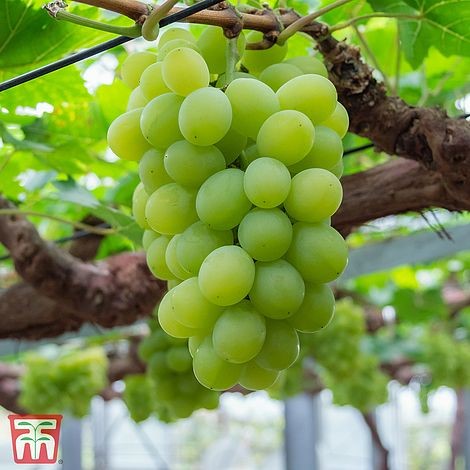
Muscat Alexandria is a popular grape variety that can be grown indoors. Contrary to what its name sounds like, it originated from the Mediterranean region and set fruits in long summers and warm weather. Muscat Alexandria has several names in different countries, such as:
- Australia: Muscat Gordo Blanco and Lexia
- France: Muscat d’Alexandrie or Muscat Romain
- Greece (Northern Aegean Islands): Muscat d’Alexandrie, Moschato Alexandria
- Greece (Limnos Island): Moschato Limnou
- Italy: Moscato d’Alessandria
- Portugal: Moscatel Graúdo or Moscatel de Setúbal
- Sicily: Zibibbo
- South Africa: Hanepoot
- South America: Moscatel
- Spain: Moscatel de Alejandría, Moscatel or even Moscatel de Málaga
Muscat Alexandria adapts to the indoor setting because of its need for a long exposure to warm air and soil. It is susceptible to bunch rot and powdery mildew and benefits from a dry climate and good air circulation.
This variety is ideal to start if you want to produce delectable wines from grape harvest. Its wine has an aromatic and marmalade-like flavor when converted to wine.
Black Hamburg

Black Hamburg is another popular variety of grapes that loves long exposure to a warm environment. It is often mistaken as to its parents, Muscat of Alexandria and Schiava Grossa.
Commonly, it is produced as a table wine but also serves as a dessert wine in the US. There are several local names given to this variety, such as:
- Black Muscat
- Muscat Hamburg
- Golden Hamburg
- France: Muscat de Hambourg (or Hamburg)
- Italy: Moscato di Amburgo
- Russia: Muscat Gamburgskiy
The wine produced from Black Hamburg grapes is rich in color and light in flavor. The fruits are sweet and come in dark red or purple color.
Gardeners must brace themselves in growing this variety since it grows fast. The flowering period of Black Hamburg is during June and July, so you should expect the fruits to set in the late weeks of summer.
Early Muscat
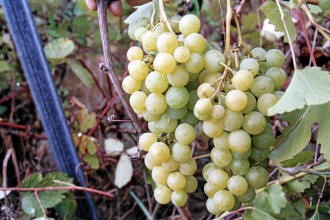
If you’re up for some fresh grapes to munch on, Early Muscat is the best variety to try. It is a cross-breed of Black Hamburg and Queen of the Vineyards or Szölöskertek Királynöje.
Unlike Muscat varieties, it is an early ripening variety that tastes like peaches and is light in color. Early Muscat serves as a table grape and is commercially produced as white wine in California and Oregon.
Most grape breeders and growers love Early Muscat because of its short growing period. It has the features you’ll love in a fresh grape. These features include a subtle crunch, sweet flesh, and flavorful skin. It is rarely produced as wine but a popular variety for making non-alcoholic or sparkling wine.
Seyval Blanc
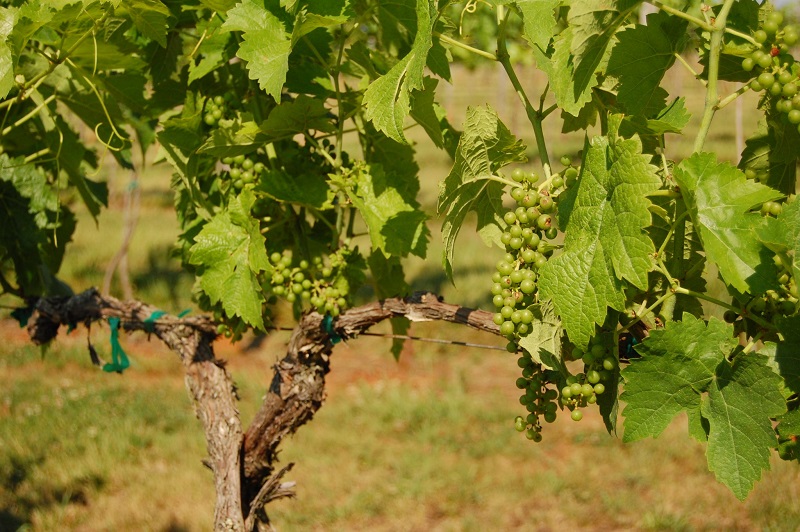
Seyval Blanc is a cross-breed of French wine grape varieties. It has green skin and has a taste between Chardonnay and Sauvignon Blanc.
Many gardeners are fond of its early ripening feature. It is one of the controversial grape varieties because the wine it produces is not considered by EU authorities as a quality wine.
Today, Seyval Blanc is exclusively produced in the Finger Lakes region in New York as a dry white wine. You can grow it indoors since it can adapt to a warm indoor environment. Other local names for Seyval Blanc are as follows:
- Seival
- Seyval
- Seyve Villard 5-276
- Seyve Villard 5276
- SV 5276
Canadice
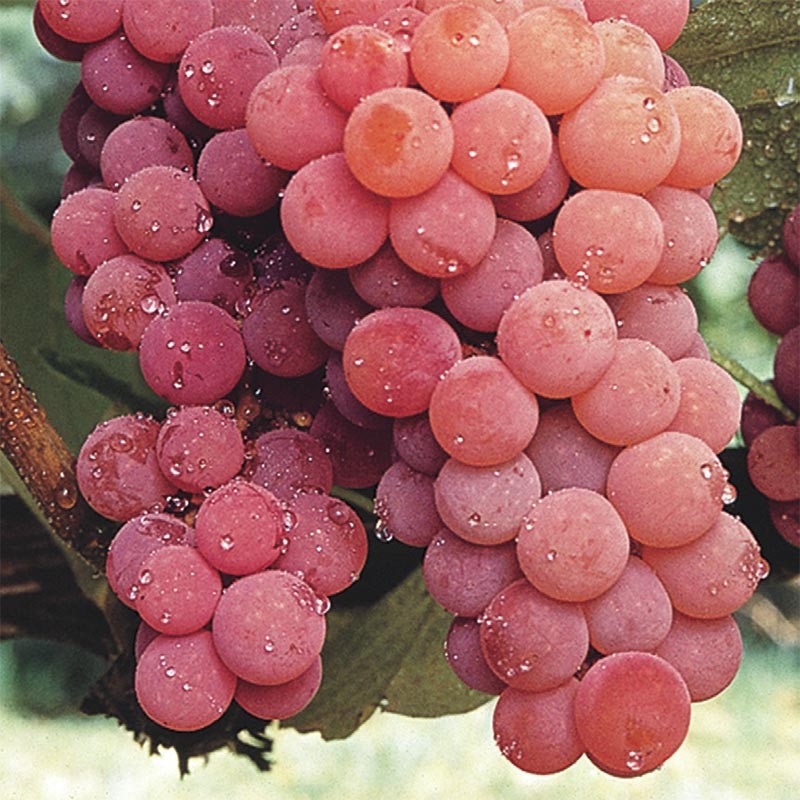
Canadice is a grape variety that can be turned into a wine, jelly, grape juice, or salad. It is seedless and belongs to the late-ripening varieties of grapes. Unlike your usual grapes, Canadice is sweet but with a hint of spiciness.
Gardeners like the Cana dice variety because aside from its versatile flavor, it is self-pollinating and ripens in September. The only catch is it is susceptible to several plant diseases, such as:
- Black rot
- Downy mildew
- Botrytis
- Powdery mildew
Proper preventive disease control can help keep the fungal disease at bay. Home gardeners utilize sulfur dioxide fumigation to help mitigate any potential spores that get to the grapevine.
Other grape varieties adaptable to an indoor environment are Interlaken and Swenson Red.
Ideal Growing Conditions For Growing Grapes Indoors
The indoor environment requires different mediums and adjustments to grow grapes successfully.
Here are some of the growing requirements and steps that you need to prepare in growing grapes indoors:
Seed Germination and Bare-Rooted Cane Preparation
Grape seeds are not widely available online. However, you can find them in local nurseries and local grape growers in your area. You can either buy them as seeds or as seedlings. You may also ask for a bare-root or dormant grape variety from your neighbors.
For planting grape seeds, you can start them in a 5-gallon pot and transplant them into a bigger pot once the vines start to crawl.
For bare-root and dormant grape canes, soak the roots in water for 3 to 4 hours. Remove excess canes and roots and place the soil below the lowest bud.
Sun and Temperature Requirements
Grapevines need full sun to grow flowers and set fruit. They need approximately 6 hours of sun. The indoor temperature throughout early spring to late fall should be 61°F and above.
Though it’s tempting to place grapes near the heater to keep them warm, it will only dry them up. Grapes need to go dormant during winter because it allows shoots to turn into canes and spread new shoots.
Soil and Pot Requirements
Grapevines need adequate space for their roots to spread. Their roots grow deep in the soil and spread as wide as their vines. You need big pots to grow indoors that should be around 5 to 20-gallon pots.
Pro Tip: Pots for tomatoes are also good for grapes. They are deep and some models come with a trellis.
A bigger pot allows the stem to support the clusters of fruits properly and gives it enough space to spread its roots.
Here are some ideal options to try:
- VIVOSUN 5-Pack 25 Gallon Plant Grow Bags
- Hydrofarm GCTR 10 Gal Tomato Garden Planting Grow System with 4 Foot Trellis
- Amazon Basics Compact Wicker Planter with Trellis
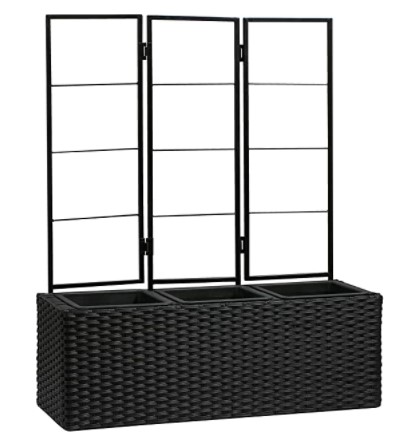
As most gardeners know, potting soil should be light and well-draining. Grapes, in particular, benefit a lot from light and well-draining soil, where the roots can move freely and get access to oxygen.
Some gardeners place gravel at the bottom of the pot or add more drainage holes to improve water drainage. Grapes love warm soil to grow well, so refrain from adding mulch.
Here are some of the ideal potting soil you can use for planting grape seeds or seedlings:
Location
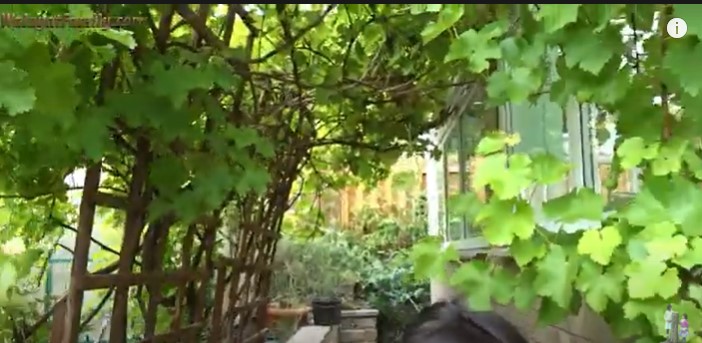
Place your indoor grapes next to a wall, shelf, or any support system where they can receive direct sunlight or light shade for at least 6 hours.
Some gardeners plant the grapevines outdoors and train the vines to go inside the greenhouse for warmth.
In some cases, the sunny part of a greenhouse or sunroom is away from any wall or shelf. You may place a DIY trellis on the pot to help train the vines. Here’s how:
Materials:
- 4 to 5 thin bamboo sticks
- Cotton string
- Glue gun
Directions:
- Place two sturdy bamboo sticks vertically on each side of the pot. You can either stick them in the soil or stick them on the pot.
- Tie another bamboo stick using the cotton string horizontally at the height of the stem. Spread the tendrils to form a T-shape to train them to go up the trellis.
- Create a second level by placing another bamboo stick 20 inches above the last horizontal bamboo stick. Check the image below for reference.
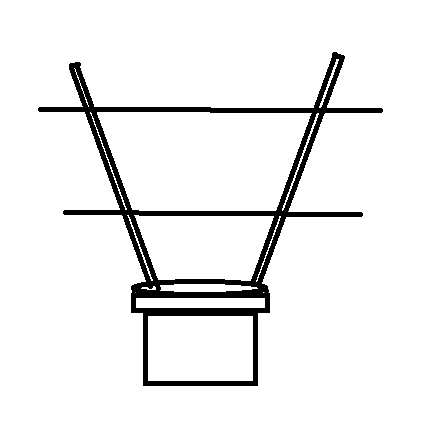
Watering Requirements
Grapevines need a lot of moisture during their first year. The water should be around 1 to 1½ inches applied once a week to encourage shoot growth. The roots of the young grapevines require being soaked in water to jumpstart leaf growth.
Check the plant daily to prevent drought stress. Keep the regular watering routine throughout the first growing season.
In the second growing season, you may notice that the stem became established, and the roots became well-adjusted to the soil. You may lessen the watering routine and just water them as needed.
Refrain from watering the foliage to prevent the development of fungal diseases. You should also reduce your watering routine during the second fall to trigger the hardening process of the grapevine. Well-established grapevines in their third or fifth year no longer need frequent watering.
Fertilization Requirements
Grapes are heavy feeders because they grow too fast every growing period. If the vines are dull and unhealthy, place a few inches of compost on its base for its nitrogen needs.
Some gardeners also recommend fertilizers high in potassium during the first two growing seasons of the grapevine.
Here are some ideal fertilizer options you can try:
- Fruit, Citrus & Vine 4-2-3 Organic Fertilizer
- Vitis-Max Grape Vine Fertilizer 1lb
- Vine Vitality Nutrient Rich Fish & Kelp Liquid Fertilizer
- Espoma Berry-Tone
Potassium encourages shoot growth in grapes. Potassium deficiency in grapes will show slow shoot growth and yellowing of leaves or chlorosis. Other than potassium, aged animal manure is sufficient to supply its growing needs every year.
Vine Training, Pruning, and Upkeep
Pruning is an essential chore in growing grapevines. Cutting back canes and shoots ensures the proper energy distribution of the plant that affects the structure of the plant and the flavor and quality of its fruits. There are several vine training systems that you can try depending on the location and space at home.
Cane pruning or guyot is a vine management strategy that involves cutting back the canes of the grapevine. It is done in regions with cooler climates to decrease the development of the brown part of the plant and limit it in the stem.
A single cane is left for the growth of flowers and fruits. Methods under this vine management are:
- Single guyot
- Double guyot
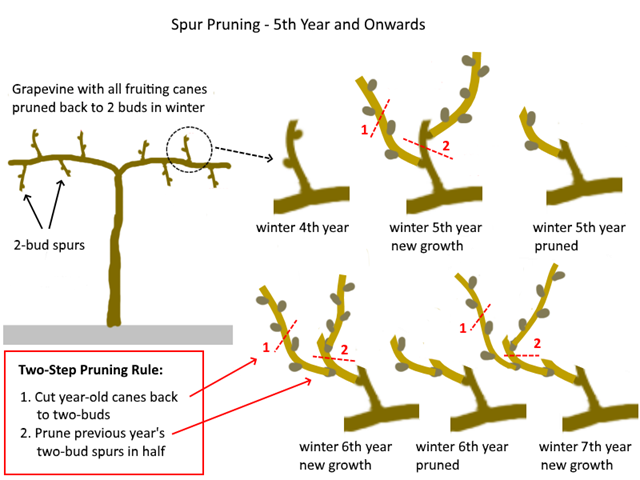
Spur pruning or cordon is a vine management strategy wherein the shoots are cut back in a certain number of spurs to manage the shoot growth. It is a method used in warmer regions and areas prone to drought.
Since indoor grapes are varieties that thrive in a warm environment, this vine management method is more applicable for you. Training methods under this vine management include:
- Geneva double curtain
- Scott Henry
- Pergola
- Lyre
- Goblet
- Basket
- Single cordon
- Double cordon
Pro Tip: High vine training methods are intended to expose the fruits to the sun. They are ideal in cooler regions where the fruits strive to get enough heat and warmth from the sun. The low vine training method keeps the fruits hidden from the harsh sun, common in hot regions.
The spacing of the vines, on the other hand, controls the fruit production and quality of the fruits. Closely spaced vines produce more but low-quality clusters, while wide spaced vines produce few but quality clusters of grapes.
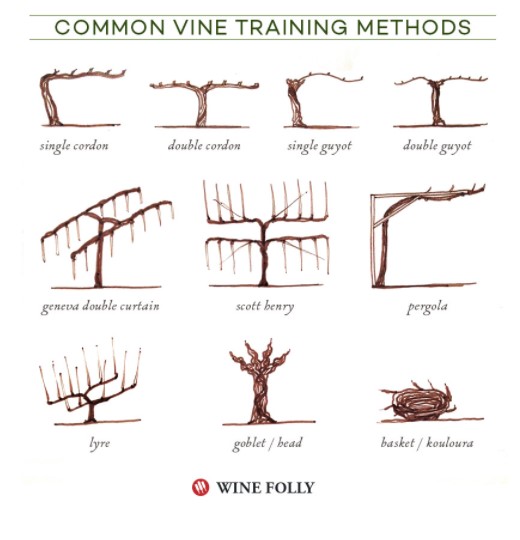
The Timeline of Grapevine Maintenance
According to the University of Minnesota, here is the grapevine maintenance that you may experience throughout the year. You may notice that the first year will be eventful.
However, the succeeding years of growing indoor grapes will require fewer plant health-boosting techniques and more pruning and maintenance.
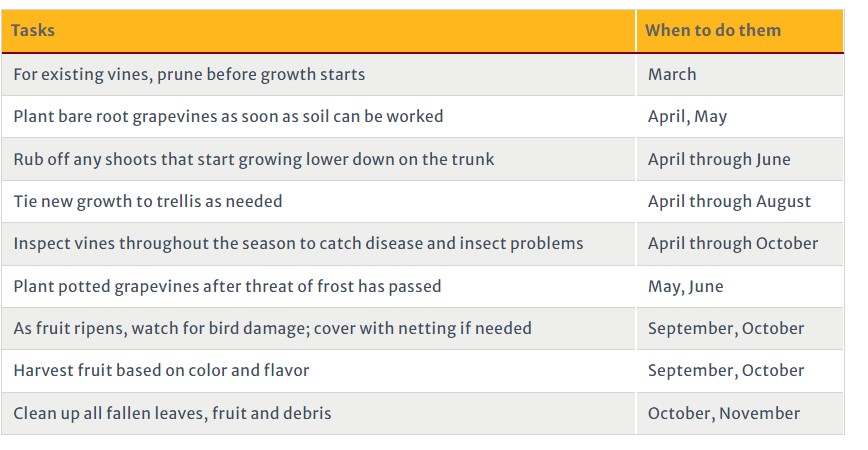
Pest Control
Some grape varieties are prone to fungal diseases, while others are more resistant. Either way, preventive pest control is essential to maintain the vigor and health of your grapevines.
Some of the pesticide and fungal disease control for grapes include:
- Sulfur dioxide fumigation
- Spinosad
- Neem oil
- Pyrethrins
Growing Grapes Indoors: A Step-By-Step Guide
Now that you have a brief idea of how to grow grapes indoors, it’s time to take some action. Start planting your first grapevines by following these steps:
Materials:
- 5-gallon pot
- 20-gallon pot
- Shovel
- Grape potting mix
- Compost
- Water
- Gravel
- Cotton string
- Five thin pieces of bamboo
- Pruning shears
Directions:
- Germinate the seeds in a seedling tray for 8 to 10 days, depending on the variety. If you want to start planting with a bare-root grape plant, soak it in water for three to four hours.
- Prepare the pots by placing gravel at the bottom. Then, place the potting soil until it reaches half of the plant pot.
- Place the seedling and spread its roots around the plant pot. Cover the roots with soil accordingly.
- Apply 1 to 2 inches of compost or aged animal manure on topsoil.
- Water the newly planted grapevine generously. Water them with 1 inch to 1 ½ inch of water every week throughout the first and second growing season.
- Once the vines start to crawl, place a trellis close to the stem.
- Tie the vines to train them up and keep them off the ground.
- Prune the shoots and remove shoots growing on the stem and any suckers at the base.
- During fall, allow the room or greenhouse to grow cold because grapevines need to dormant to turn the shoots into canes.
- In early spring, new shoots will grow in the buds where the leaves, flowers, and clusters of grapes develop.
- Apply preventive pesticides to protect the plant from fungal diseases and pest infestations.
- Harvest the fruits by September to October, depending on the ripening classification of the grape variety. Some varieties are early ripening and have shorter growing, while others are late ripening and reach until the last weeks of summer before they can be harvested.
- Clean the area and prune the grapevine to prepare for winter and the next growing season.
Final Thoughts
Growing grapes indoors is an uncommon but possible gardening practice. It goes to show that you don’t need hectares of land to produce your food.
In indoor grape cultivation, you only need to have the appropriate variety, pruning skills, and vine management to ensure a good harvest.
Seeing clusters of grapes on the ceiling of a greenhouse is a spectacle to witness. Every gardener’s dream is to pick up fruits within arms reach and enjoy their sweet and delicate taste.
Grapes can also be converted into several products. With 40 clusters in every vine, your family will have enough stock of grape jellies, wine, and grape juices for the entire year!
We hope you enjoyed learning about grapes as we enjoy sharing them with you. Please don’t forget to share this post with your friends and dive into the viticulture world together.
Let us know in the comments how much wine you were able to make out of your grape harvest!
